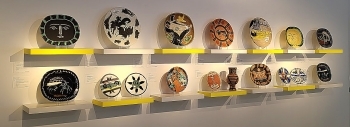Is there a Picasso on your plate?
IT IS ALWAYS WORTH ‘popping’ into Christie’s auction house in London’s Mayfair because there is usually a display of interesting objects being displayed prior to being auctioned. When we visited the place on 16 May 2025, there was a collection of ceramics created by Pablo Picasso (1881-1973). They included plates, jugs, and decorative objects.

Picasso began producing ceramic objects in 1947. The Madoura pottery studio in Vallauris, France produced blank ceramic items, which Picasso then decorated. A website dedicated to Picasso’s ceramics (https://picasso-ceramics.org/) gives much information about the artist’s involvement in this form of art, and I have quoted from it below. The website explained that Picasso began producing ceramics because:
“… the high prices and relative rarity of Picasso’s paintings meant that most people would never be able to own one, the artist liked the idea of working in a medium that would be more accessible to the average person. He realized that pottery could be produced on a scale that his paintings could not. With prices of around $100 in the 1950s and 1960s, Picasso’s ceramic series were far more financially accessible than his previous artworks. The utilitarian nature of his pottery also made the art form more appealing to the general public, who may not understand the appeal of an abstract painting, but who could appreciate the value of a beautiful plate or pitcher.”
As he had never worked with ceramics before this, he had to develop his techniques and learn how materials behaved when they were incorporated with ceramics. However, his experience with lithography assisted him, as the following explained:
“Since Picasso had no prior training in ceramics, professional potters at Madoura would create blank ceramic objects for him to work with. He would then reshape, paint, and engrave the pottery to create his original designs. Picasso had previous experience engraving lithographs, which informed the methods he used to engrave his pottery, as well as his choice to release the pottery in numbered editions. While this numbering practice was common for lithographs at the time, it was relatively unheard of for pottery.”
The designs on Picasso’s attractive ceramics were largely inspired by Spanish folk art. The auction house beautifully displayed the objects that will come up for sale on 22 May 2025. If you are interested in owning a piece, it is an online auction: https://onlineonly.christies.com/s/picasso-ceramics/lots/3722



